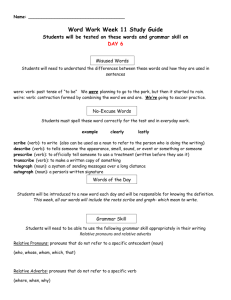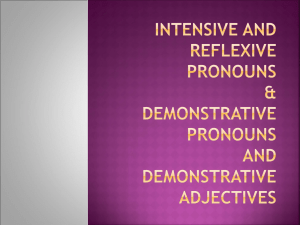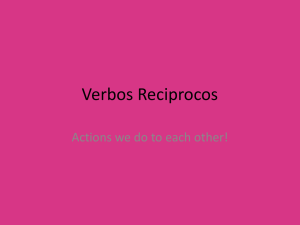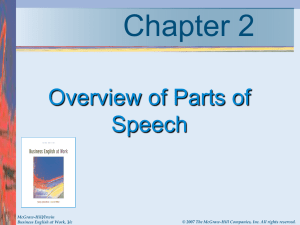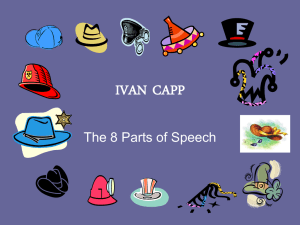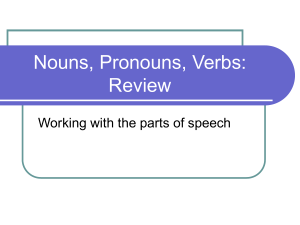LTHS English I Pre-AP: Parts of Speech Review Packet Experienced
advertisement
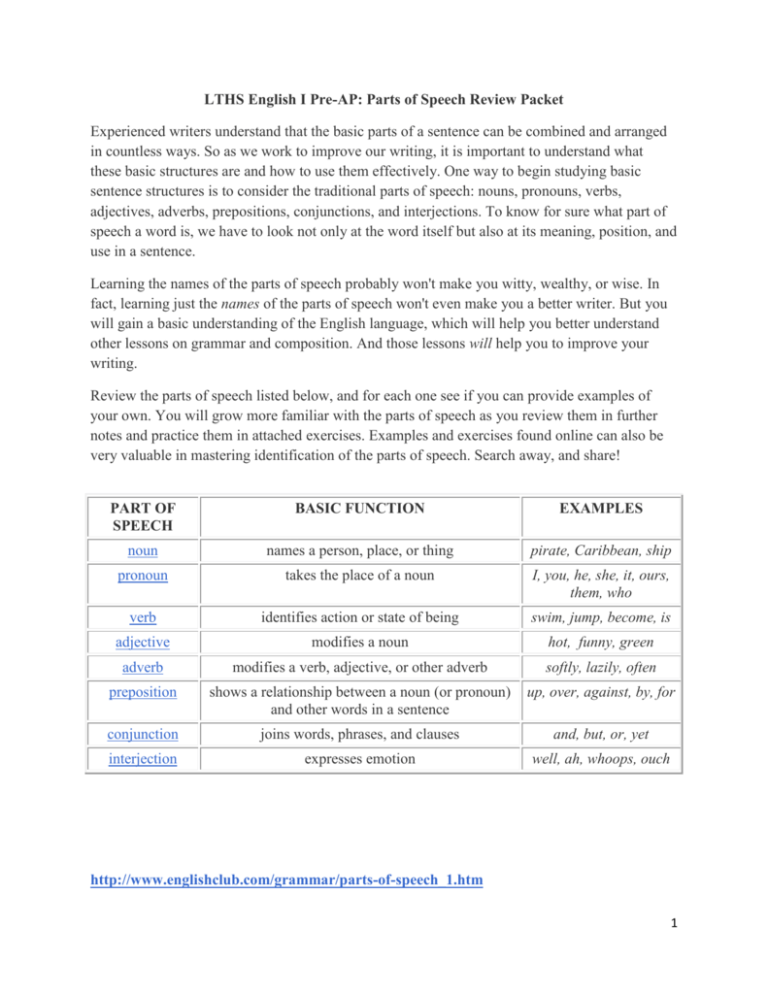
LTHS English I Pre-AP: Parts of Speech Review Packet Experienced writers understand that the basic parts of a sentence can be combined and arranged in countless ways. So as we work to improve our writing, it is important to understand what these basic structures are and how to use them effectively. One way to begin studying basic sentence structures is to consider the traditional parts of speech: nouns, pronouns, verbs, adjectives, adverbs, prepositions, conjunctions, and interjections. To know for sure what part of speech a word is, we have to look not only at the word itself but also at its meaning, position, and use in a sentence. Learning the names of the parts of speech probably won't make you witty, wealthy, or wise. In fact, learning just the names of the parts of speech won't even make you a better writer. But you will gain a basic understanding of the English language, which will help you better understand other lessons on grammar and composition. And those lessons will help you to improve your writing. Review the parts of speech listed below, and for each one see if you can provide examples of your own. You will grow more familiar with the parts of speech as you review them in further notes and practice them in attached exercises. Examples and exercises found online can also be very valuable in mastering identification of the parts of speech. Search away, and share! PART OF SPEECH BASIC FUNCTION EXAMPLES noun names a person, place, or thing pirate, Caribbean, ship pronoun takes the place of a noun I, you, he, she, it, ours, them, who verb identifies action or state of being swim, jump, become, is adjective modifies a noun hot, funny, green adverb modifies a verb, adjective, or other adverb softly, lazily, often preposition shows a relationship between a noun (or pronoun) and other words in a sentence up, over, against, by, for conjunction joins words, phrases, and clauses and, but, or, yet interjection expresses emotion well, ah, whoops, ouch http://www.englishclub.com/grammar/parts-of-speech_1.htm 1 II. NOUNS The simple definition is: a person, place, thing, or idea. Here are some examples: person: man, woman, teacher, John, Mary place: home, office, town, countryside, America thing: table, car, banana, money, music, love, dog, monkey idea: love, joy, peace, patience, kindness, gentleness, faithfulness, self-control Three ways of recognizing a noun are by its: Ending, Position, or Function 1. Noun Ending There are certain word endings that show that a word is a noun, for example: -ity > nationality -ment > appointment -ness > happiness -ation > relation -hood > childhood But this is not true for the word endings of all nouns. For example, the noun "spoonful" ends in -ful, but the adjective "careful" also ends in -ful. 2. Position in Sentence We can often recognize a noun by its position in the sentence. Nouns often come after a determiner (a determiner is a word like a, an, the, this, my, such): a relief an afternoon the doctor this word my house such stupidity Nouns often come after one or more adjectives: a great relief a peaceful afternoon the tall, Indian doctor this difficult word my brown and white house such crass stupidity 2 3. Function in a Sentence Nouns have certain functions (jobs) in a sentence, for example: subject of verb: Doctors work hard. object of verb: He likes coffee. subject and object of verb: Teachers teach students. II. PRONOUNS Pronouns are small words that take the place of a noun. We can use a pronoun instead of a noun. Pronouns are words like: he, you, ours, themselves, some, and each... The noun a pronoun replaces is called its antecedent. There are many types of pronouns: Personal pronouns represent specific people or things. We use them depending on: number: singular (eg: I) or plural (eg: we) person: 1st person (eg: I), 2nd person (eg: you) or 3rd person (eg: he) gender: male (eg: he), female (eg: she) or neuter (eg: it) case: subject (eg: we) or object (eg: us) We use personal pronouns in place of the person or people that we are talking about. My name is Josef but when I am talking about myself I almost always use "I" or "me", not "Josef". When I am talking direct to you, I almost always use "you", not your name. When I am talking about another person, say John, I may start with "John" but then use "he" or "him". And so on. Examples (in each case, the first example shows a subject pronoun, the second an object pronoun): I like coffee. John helped me. Do you like coffee? John loves you. He runs fast. Did Ram beat him? She is clever. Does Mary know her? 3 It doesn't work. Can the engineer repair it? We went home. Anthony drove us. Do you need a table for three? Did John and Mary beat you at doubles? They played doubles. John and Mary beat them. When we are talking about a single thing, we almost always use it. However, there are a few exceptions. We may sometimes refer to an animal as he/him or she/her, especially if the animal is domesticated or a pet. Ships (and some other vessels or vehicles) as well as some countries are often treated as female and referred to as she/her. Here are some examples: This is our dog Rusty. He's an Alsatian. The Titanic was a great ship but she sank on her first voyage. My first car was a Mini and I treated her like my wife. Thailand has now opened her border with Cambodia. For a single person, sometimes we don't know whether to use he or she. There are several solutions to this: If a teacher needs help, he or she should see the principal. If a teacher needs help, he should see the principal. If a teacher needs help, they should see the principal. Demonstrative Pronouns represents a thing or things: near in distance or time (this, these) far in distance or time (that, those) near far singular this that plural these those 4 Possessive Pronouns refer to a specific person/people or thing/things (the "antecedent") belonging to a person/people (and sometimes belonging to an animal/animals or thing/things). We use possessive pronouns depending on: number: singular (eg: mine) or plural (eg: ours) person: 1st person (eg: mine), 2nd person (eg: yours) or 3rd person (eg: his) gender: male (his), female (hers) Below are the possessive pronouns, followed by some example sentences. Notice that each possessive pronoun can: be subject or object refer to a singular or plural antecedent number person gender (of "owner") possessive pronouns 1st male/female mine 2nd male/female yours male his female hers 1st male/female ours 2nd male/female yours 3rd male/female/neuter theirs singular 3rd plural Look at these pictures. Mine is the big one. (subject = My picture) I like your flowers. Do you like mine? (object = my flowers) I looked everywhere for your key. I found John's key but I couldn't find yours. (object = your key) My flowers are dying. Yours are lovely. (subject = Your flowers) All the essays were good but his was the best. (subject = his essay) John found his passport but Mary couldn't find hers. (object = her passport) John found his clothes but Mary couldn't find hers. (object = her clothes) Here is your car. Ours is over there, where we left it. (subject = Our car) Your photos are good. Ours are terrible. (subject = Our photos) Each couple's books are color-coded. Yours are red. (subject = Your books) I don't like this family's garden but I like yours. (subject = your garden) 5 These aren't John and Mary's children. Theirs have black hair. (subject = Their children) John and Mary don't like your car. Do you like theirs? (object = their car) Interrogative Pronouns ask questions. The interrogative pronoun represents the thing that we don't know (what we are asking the question about). There are four main interrogative pronouns: who, whom, what, which Notice that the possessive pronoun whose can also be an interrogative pronoun (an interrogative possessive pronoun). person subject object who whom thing what person/thing which person whose (possessive) Notice that whom is the correct form when the pronoun is the object of the verb, as in "Whom did you see?" ("I saw John.") However, in normal, spoken English we rarely use whom. Most native speakers would say (or even write): "Who did you see?" Look at these example questions. In the sample answers, the noun phrase that the interrogative pronoun represents is shown in bold. Note that we sometimes use the suffix "-ever" to make compounds from some of these pronouns (mainly whoever, whatever, whichever). When we add "-ever", we use it for emphasis, often to show confusion or surprise. Look at these examples: Whoever would want to do such a nasty thing? Whatever did he say to make her cry like that? They're all fantastic! Whichever will you choose? 6 Reflexive Pronouns refer back to the subject of the sentence or clause. Reflexive pronouns end in "-self" (singular) or "-selves" (plural). There are eight reflexive pronouns: reflexive pronoun singular myself yourself himself, herself, itself plural ourselves yourselves themselves Intensive pronouns Notice that all the above reflexive pronouns can also act as intensive pronouns, but the function and usage are different. An intensive pronoun emphasizes its antecedent. Look at these examples: I made it myself. OR I myself made it. Have you yourself seen it? OR Have you seen it yourself? The President himself promised to stop the war. She spoke to me herself. OR She herself spoke to me. The exam itself wasn't difficult, but exam room was horrible. Never mind. We'll do it ourselves. You yourselves asked us to do it. They recommend this book even though they themselves have never read it. OR They recommend this book even though they have never read it themselves. Reciprocal Pronouns express mutual action. We use reciprocal pronouns when each of two or more subjects is acting in the same way towards the other. For example, A is talking to B, and B is talking to A. So we say: A and B are talking to each other. The action is "reciprocated". John talks to Mary and Mary talks to John. I give you a present and you give me a present. The dog bites the cat and the cat bites the dog. There are only two reciprocal pronouns, and they are both two words: each other one another 7 When we use these reciprocal pronouns: there must be two or more people, things or groups involved (so we cannot use reciprocal pronouns with I, you [singular], he/she/it), and they must be doing the same thing Indefinite Pronouns do not refer to any specific person, thing or amount. It is vague and "not definite". Some typical indefinite pronouns are: all, another, any, anybody/anyone, anything, each, everybody/everyone, everything, few, many, nobody, none, one, several, some, somebody/someone Note that many indefinite pronouns also function as other parts of speech. Look at "another" in the following sentences: He has one job in the day and another at night. (pronoun) I'd like another drink, please. (adjective) Most indefinite pronouns are either singular or plural. However, some of them can be singular in one context and plural in another. Notice that a singular pronoun takes a singular verb AND that any personal pronoun should also agree (in number and gender). Relative Pronouns introduce a relative clause. It is called a "relative" pronoun because it "relates" to the word that it modifies. Here is an example: The person who phoned me last night is my teacher. In the above example, "who": relates to "person", which it modifies introduces the relative clause "who phoned me last night" There are five relative pronouns: who, whom, whose, which, that* Who (subject) and whom (object) are generally only for people. Whose is for possession. Which is for things. In non-defining relative clauses, that is used for things. In defining relative clauses (clauses that are essential to the sentence and do not simply add extra information) that can be used for things and people 8 III. VERBS Verbs are sometimes described as "action words". This is partly true. Many verbs give the idea of action, of "doing" something. For example, words like run, fight, do and work all convey action. But some verbs do not give the idea of action; they give the idea of existence, of state, of "being". For example, verbs like be, exist, seem and belong all convey state. A verb always has a subject. (In the sentence "John speaks English", John is the subject and speaks is the verb.) In simple terms, therefore, we can say that verbs are words that tell us what a subject does or is; they describe: action (Ram plays football.) state (Anthony seems kind.) We divide verbs into two broad classifications: 1. Helping Verbs Imagine that a stranger walks into your room and says: I can. People must. The Earth will. Do you understand anything? Has this person communicated anything to you? Probably not! That's because these verbs are helping verbs and have no meaning on their own. They are necessary for the grammatical structure of the sentence, but they do not tell us very much alone. We usually use helping verbs with main verbs. They "help" the main verb. (The sentences in the above examples are therefore incomplete. They need at least a main verb to complete them.) There are only about 15 helping verbs. 2. Main Verbs Now imagine that the same stranger walks into your room and says: I teach. People eat. The Earth rotates. 9 Do you understand something? Has this person communicated something to you? Probably yes! Not a lot, but something. That's because these verbs are main verbs and have meaning on their own. They tell us something. Of course, there are thousands of main verbs. Main verbs have meaning on their own (unlike helping verbs). There are thousands of main verbs, and we can classify them in several ways: A. Transitive and intransitive verbs A transitive verb takes a direct object: Somebody killed the President. An intransitive verb does not have a direct object: He died. Many verbs, like speak, can be transitive or intransitive. Look at these examples: Transitive: I saw an elephant. We are watching TV. He speaks English. Intransitive: He has arrived. John goes to school. She speaks fast. B. Linking verbs A linking verb does not have much meaning in itself. It "links" the subject to what is said about the subject. Usually, a linking verb shows equality (=) or a change to a different state or place (>). Linking verbs are always intransitive (but not all intransitive verbs are linking verbs). Mary is a teacher. (mary = teacher) Tara is beautiful. (tara = beautiful) That sounds interesting. (that = interesting) The sky became dark. (the sky > dark) The bread has gone bad. (bread > bad) 10 IV. ADJECTIVES An adjective is a word that tells us more about a noun. (By "noun" we include pronouns and noun phrases.) An adjective "qualifies" or "modifies" a noun (a big dog). Adjectives can be used before a noun (I like Chinese food) or after certain verbs (It is difficult). We can often use two or more adjectives together (a beautiful young French lady). Comparative Adjectives When we talk about two things, we can "compare" them. We can see if they are the same or different. Perhaps they are the same in some ways and different in other ways. We can use comparative adjectives to describe the differences. *We can use comparative adjectives when talking about two things (not three or more things). Superlative Adjectives A superlative adjective expresses the extreme or highest degree of a quality. We use a superlative adjective to describe the extreme quality of one thing in a group of things. *We can use superlative adjectives when talking about three or more things (not two things). V. ADVERBS An adverb is a word that tells us more about a verb. It "qualifies" or "modifies" a verb (The man ran quickly). In the following examples, the adverb is in bold and the verb that it modifies is in italics. John speaks loudly. (How does John speak?) Afterwards she smoked a cigarette. (When did she smoke?) Mary lives locally. (Where does Mary live?) But adverbs can also modify adjectives (Tara is really beautiful), or even other adverbs (It works very well). Look at these examples: Modify an adjective: - He is really handsome. (How handsome is he?) - That was extremely kind of you. 11 Modify another adverb: - She drives incredibly slowly. (How slowly does she drive?) - He drives extremely fast. The basic kinds of adverbs are: Adverbs of Manner tell us the manner or way in which something happens. They answer the question "how?". Adverbs of Manner mainly modify verbs. He speaks slowly. (How does he speak?) They helped us cheerfully. (How did they help us?) James Bond drives his cars fast. (How does James Bond drive his cars?) Adverbs of Place tell us the place where something happens. They answer the question "where?". Adverbs of Place mainly modify verbs. Please sit here. (Where should I sit?) They looked everywhere. (Where did they look?) Two cars were parked outside. (Where were two cars parked?) Adverbs of Time tell us something about the time that something happens. Adverbs of Time mainly modify verbs. They can answer the question "when?": He came yesterday. (When did he come?) I want it now. (When do I want it?) Or they can answer the question "how often?": They deliver the newspaper daily. (How often do they deliver the newspaper?) We sometimes watch a movie. (How often do we watch a movie?) Adverbs of Degree tell us the degree or extent to which something happens. They answer the question "how much?" or "to what degree?". Adverbs of Degree can modify verbs, adjectives and other adverbs. She entirely agrees with him. (How much does she agree with him?) Mary is very beautiful. (To what degree is Mary beautiful? How beautiful is Mary?) 12 He drove quite dangerously. (To what degree did he drive dangerously? How dangerously did he drive?) VI. PREPOSITIONS A preposition is a word governing, and usually coming in front of, a noun or pronoun and expressing a relation to another word or element, as in: She left before breakfast. What did you come for? (For what did you come?) There are about 150 prepositions in English. Yet this is a very small number when you think of the thousands of other words (nouns, verbs etc). Prepositions are important words. We use individual prepositions more frequently than other individual words. In fact, the prepositions of, to and in are among the ten most frequent words in English. Here is a short list of 70 of the more common one-word prepositions. Many of these prepositions have more than one meaning. Please refer to a dictionary for precise meaning and usage. Here is a short list of the most common: about above across after against around at before behind below beneath beside besides between beyond by down during except for from in inside into like near of off on out outside over since through throughout till to toward under until up upon with without according to because of by way of in addition to in front of in place of in regard to in spite of instead of on account of out of 13 VII. CONJUNCTIONS A conjunction is a word that "joins". A conjunction joins two parts of a sentence. Here are some example conjunctions: Coordinating Conjunctions Subordinating Conjunctions and, but, or, nor, for, yet, so although, because, since, unless We can consider conjunctions from three aspects. Form Conjunctions have three basic forms: Single Word for example: and, but, because, although Compound (often ending with as or that) for example: provided that, as long as, in order that Correlative (surrounding an adverb or adjective) for example: so...that Function Conjunctions have two basic functions or "jobs": Coordinating conjunctions are used to join two parts of a sentence that are grammatically equal. The two parts may be single words or clauses, for example: - Jack and Jill went up the hill. - The water was warm, but I didn't go swimming. Subordinating conjunctions are used to join a subordinate dependent clause to a main clause, for example: - I went swimming although it was cold. Position Coordinating conjunctions always come between the words or clauses that they join. Subordinating conjunctions usually come at the beginning of the subordinate clause. 14 A. Coordinating Conjunctions The short, simple conjunctions are called "coordinating conjunctions": and, but, or, nor, for, yet, so A coordinating conjunction joins parts of a sentence (for example words or independent clauses) that are grammatically equal or similar. A coordinating conjunction shows that the elements it joins are similar in importance and structure: + Look at these examples - the two elements that the coordinating conjunction joins are shown in square brackets [ ]: I like [tea] and [coffee]. [Ram likes tea], but [Anthony likes coffee]. Coordinating conjunctions always come between the words or clauses that they join. When a coordinating conjunction joins independent clauses, it is always correct to place a comma before the conjunction: I want to work as an interpreter in the future, so I am studying Russian at university. However, if the independent clauses are short and well-balanced, a comma is not really essential: She is kind so she helps people. The 7 coordinating conjunctions are short, simple words. They have only two or three letters. There's an easy way to remember them - their initials spell: F A N B O Y S For And Nor But Or Yet So B. Subordinating Conjunctions The majority of conjunctions are "subordinating conjunctions". Common subordinating conjunctions are: after, although, as, because, before, how, if, once, since, than, that, though, till, until, when, where, whether, while 15 A subordinating conjunction joins a subordinate (dependent) clause to a main (independent) clause: + Look at this example: main or independent clause subordinate or dependent clause Ram went swimming although it was raining. subordinating conjunction A subordinate or dependent clause "depends" on a main or independent clause. It cannot exist alone. Imagine that somebody says to you: "Hello! Although it was raining." What do you understand? Nothing! But a main or independent clause can exist alone. You will understand very well if somebody says to you: "Hello! Ram went swimming." A subordinating conjunction always comes at the beginning of a subordinate clause. It "introduces" a subordinate clause. However, a subordinate clause can sometimes come after and sometimes before a main clause. Thus, two structures are possible: Ram went swimming although it was raining. Although it was raining, Ram went swimming. VIII. INTERJECTIONS Hi! That's an interjection. :-) Interjection is a big name for a little word. Interjections are short exclamations like Wow!, Oh!, Um or Ah! We use them quite often, usually more in speaking than in writing. An interjection is sometimes followed by an exclamation mark (!) when written. 16

